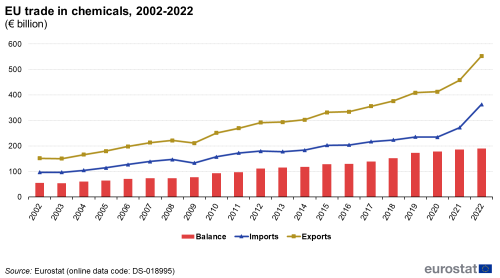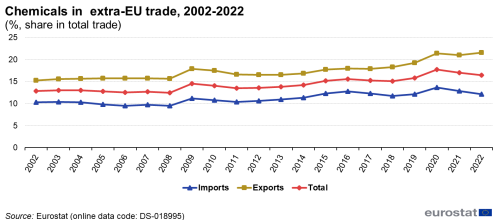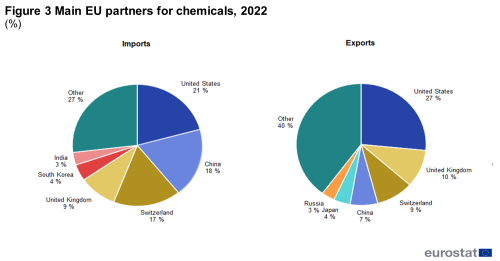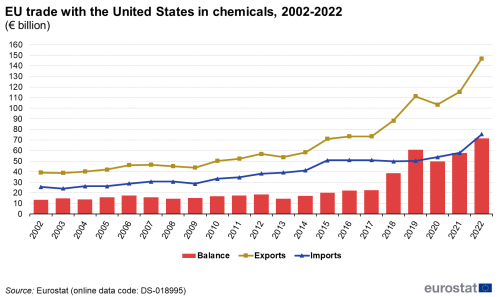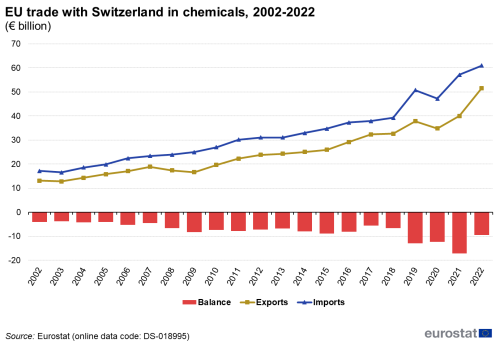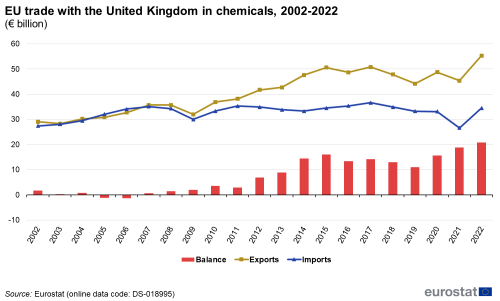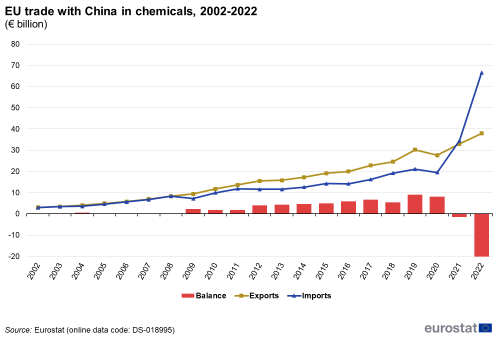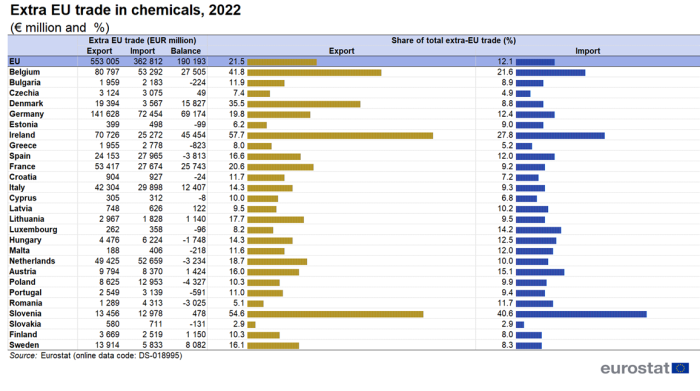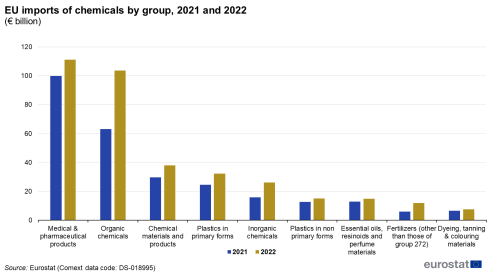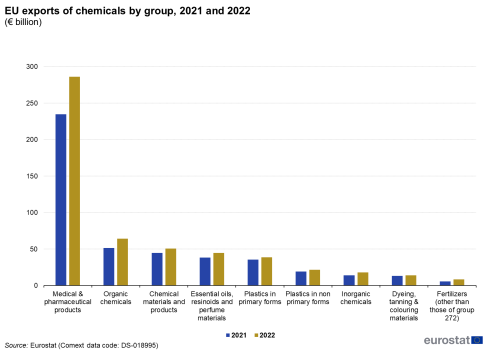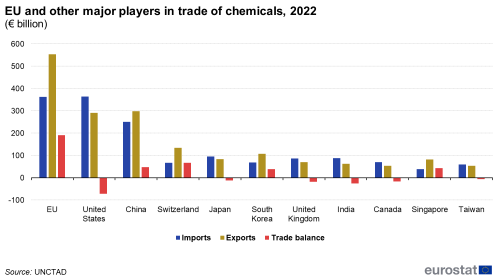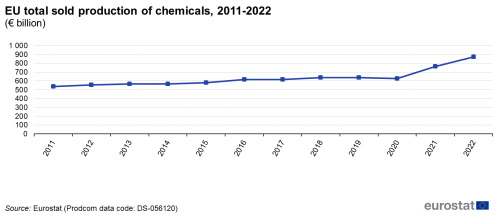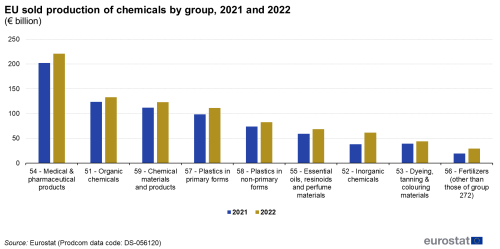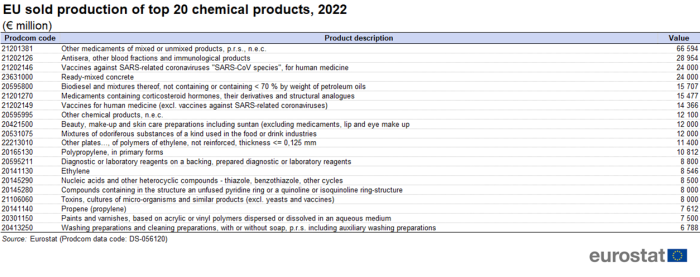Production and international trade in chemicals
Data from September 2023 Planned update:September 2024
Highlights
Sold production of chemicals grew from € 537 billion in 2011 to € 872 billion in 2022.
Between 2011 and 2022, sold production grew strongest for inorganic chemicals among the different groups of chemicals.
EU imports (+33 %) and exports (+21 %) of chemicals grew strongly between 2021 and 2022.
The United States, Switzerland, the United Kingdom and China were the four largest partners of the EU for exports and imports of chemicals in 2022.
EU trade in chemicals, 2012-2022
This article presents statistics on the European Union’s (EU) sold production and trade in chemical products. It focuses on the EU imports and exports of chemicals with the rest of the world, as well as on how they are related to the total EU sold production of chemicals.
This article is part of an online publication providing recent statistics on international trade in goods, covering information on the EU's main partners, main products traded, specific characteristics of trade as well as background information.
Full article
Strong growth of trade in chemicals in 2022
The value of EU imports of chemicals grew from €97 billion in 2002 to €363 billion in 2022, equivalent to an average annual growth of 6.8% (Figure 1). In the same period exports grew from €152 billion to €553 billion equivalent to an average annual growth of 6.7%. The EU had a growing trade surplus in chemicals throughout the 2002–2022 period. The surplus grew from €55 billion in 2002 to €190 billion in 2022.
Coming out of the COVID-19 crisis, imports (+16 %) and exports (+11 %) of chemicals grew strongly in 2021. Fueled by increasing prices, growth was even stronger in 2022 with imports increasing by 33 % and exports increasing by 21 %.
The share of chemicals in total (imports + exports) extra-EU trade increased from 12.8% in 2002 to 16.4 % in 2022, an increase of 3.6 percentage points (pp). The share of imports grew by 1.8 pp while exports grew more strongly by 6.3 pp (Figure 2).
Main extra-EU partners for trade in chemicals
The United States, Switzerland, China and the United Kingdom were the EU's largest partners for both exports and imports of chemicals in 2021 (see Figure 3). For imports, the United States (21%) was the largest partner, followed by China (18%), Switzerland (17%) and the United Kingdom (9%). The United States (27%) was also the largest export destination, followed by the United Kingdom (10%), Switzerland (9%) and China (7%).
From 2002 to 2022 the EU always had a surplus for trade in chemicals with the United States which peaked in 2022 at €72 billion Following a decrease in 2020 due to the COVID-19 pandemic, imports (+7 %) and especially exports (+12 %) grew in 2021. In 2022 growth was even stronger for both imports (+30 %) and exports (+27 %) fueled by sharply increasing prices.
From 2002 to 2022, the EU always had a deficit for trade in chemicals with Switzerland. It peaked in 2021 at €17 billion, falling to €9 billion in 2022. Both imports (+21 %) and exports (+15 %) grew in 2021. In 2022 growth was even stronger for exports (+29 %) while imports grew less strongly (+7 %).
From 2002 to 2008 EU imports from and exports to the United Kingdom of chemicals were almost balanced. Since then exports grew stronger than imports. This resulted in a peak trade surplus of €21 billion in 2022. Unlike trade with Switzerland and the United States both imports (-20 %) and exports (-7 %) fell in 2021. However, in 2022, both imports (+30 %) and exports (+22 %) grew strongly.
From 2002 to 2008 EU imports from and exports to China were almost balanced. Between 2008 and 2020 exports grew faster than imports, resulting in a trade surplus that peaked in 2019 at €9 billion. In 2021 (+19 %) and 2022 (+15 %) imports from China grew. However, exports in 2021 (+77 %) and 2022 (+93 %) grew much stronger, resulting in a peak trade deficit of €29 billion in 2022.
Trade in chemicals by Member State
There were six Member States exporting more than €30 billion of chemicals to countries outside the EU in 2022 (see Table 1). These were Germany (€142 billion), Belgium (€81 billion), Ireland (€71 billion), France (€53 billion), the Netherlands (€49 billion) and Italy (€42 billion).
Germany (€72 billion), the Netherlands and Belgium ( both €53 billion) were the only three EU Member States importing more than €30 billion of chemicals from outside the EU in 2021.
In 2022, Germany registered the highest trade surplus in chemicals of any EU Member State (€69 billion) followed by Ireland (€45 billion), Belgium (€28 billion) and France (€26 billion). The largest deficits were registered in Spain and Poland (both €4 billion).
In Ireland (57%) and Slovenia (55%) exports of chemicals made up more than half of total exports. Slovenia (41%) also had the highest share for chemicals in total imports followed by Ireland (28%).
Trade of chemicals by product
In 2021 and 2022, the largest product group in extra-EU imports of chemicals was 'Medical and pharmaceutical products' (see Figure 8). The value of imports increased from €100 billion to €112 billion, equivalent to a growth rate of 12 %. The second largest group was 'Organic chemicals' growing from €63 billion to €104 billion, a growth rate of 64 %. The highest growth rate was seen in the 'Fertilizer' group whose imports doubled from €6 billion to €12 billion, due to increasing prices following Russia's invasion of the Ukraine.
In 2021 and 2022, the largest product group in extra-EU exports of chemicals was 'Medical and pharmaceutical products' (see Figure 9). The value of exports increased from €235 billion to €287 billion, equivalent to a growth rate of 22 %. The second largest group was 'Organic chemicals' growing from €51 billion to €64 billion, a growth rate of 26 %. The highest growth rate was seen in the 'Fertilizer' group whose exports grew by 50 % from €6 billion to €9 billion..
EU is the largest exporter of chemical products
Looking at the major international players in chemicals trade, the EU headed the list in 2021 with a total trade of €730 billion, which consisted of €458 billion of exports and €272 billion of imports, thus recording the highest trade surplus ( €186 billion) as shown in Figure 10. The United States was the largest importer (€279 billion) and second largest exporter (€229 billion) and had the largest trade deficit (€50 billion). China was both the third largest importer and exporter with €223 billion for both trade flows. Compared to 2020 China's exports increased by 50%.
Sold production of chemicals
The total sold production of chemicals in terms of value increased by €335 billion between 2011 and 2022 (see Figure 11) equivalent to an annual average growth of 4.5%. Growth was especially strong between 2020 and 2021.
Figure 12 shows that sold production grew between 2021 and 2022 in all groups. Both in absolute and relative terms, the largest increase was for inorganic chemicals, rising from €38 billion in 2021 to €61 billion in 2022 equivalent to an increase of 61.5 %.
Table 2 shows the level of the sold production for the top 20 chemical products in the EU. 'Other medicaments of mixed or unmixed products' topped the list of the most sold chemical products in the EU in value terms in 2021 with €67 billion, followed by 'Antisera, other immunological products which are directly involved in the regulation of immunological processes and other blood fractions' (€29 billion), 'Vaccines against SARS-related coronaviruses'and 'Ready-mixed concrete' (both estimated at €24 billion). No other products had a sold production above €20 billion.
Source data for tables and graphs
Data sources
International trade in goods EU data is taken from Eurostat's COMEXT database. COMEXT is the reference database for international trade in goods. It provides access not only to both recent and historical data from the EU Member States but also to statistics of a significant number of third countries. International trade aggregated and detailed statistics disseminated via the Eurostat website are compiled from COMEXT data according to a monthly process.
Data are collected by the competent national authorities of the Member States and compiled according to a harmonised methodology established by EU regulations before transmission to Eurostat. For extra-EU trade, the statistical information is mainly provided by the traders on the basis of customs declarations.
EU data are compiled according to Community guidelines and may, therefore, differ from national data published by the Member States. Statistics on extra-EU trade are calculated as the sum of trade of each of the 27 EU Member States with countries outside the EU. In other words, the EU is considered as a single trading entity and trade flows are measured into and out of the area, but not within it.
The United Kingdom is considered as an extra-EU partner country for the EU for the whole period covered by this article. However, the United Kingdom was still part of the internal market until the end of the transitory period (31 December 2020), meaning that data on trade with the United Kingdom are still based on statistical concepts applicable to trade between the EU Member States. Consequently, while imports from any other extra-EU trade partner are grouped by country of origin, the United Kingdom data reflect the country of consignment. In practice this means that the goods imported by the EU from the United Kingdom were physically transported from the United Kingdom but part of these goods could have been of other origin than the United Kingdom. For this reason, data on trade with the United Kingdom are not fully comparable with data on trade with other extra-EU trade partners.
Production of chemicals Industrial production data comes from PRODCOM. Prodcom provides statistics on the production of manufactured goods. Prodcom data includes:
- the physical volume of production sold during the survey period;
- the value of production sold during the survey period; and
- for some products, the volume of total production during the survey period.
Prodcom data is obtained by the National Statistical Institutes (NSIs) who conduct a survey of enterprises. Eurostat calculates EU totals at EU level from the national data.
International trade in chemicals Trade in goods data comes from Eurostat's COMEXT database. COMEXT is the Eurostat reference database for international trade in goods. It provides access not only to both recent and historical data from the EU Member States, but also to statistics of a significant number of non-EU countries. Because COMEXT is updated on a daily basis, data published on the website may differ from data stored in COMEXT in case of recent revisions.
Chemical products are classified according to the Standard International Trade Classification (SITC) of the United Nations. Section 5 ‘Chemicals and related products, N.E.S.’ of SITC Rev. 4 is made up of the following divisions:
- 51 Organic chemicals;
- 52 Inorganic chemicals;
- 53 Dyeing, tanning and colouring materials;
- 54 Medicinal and pharmaceutical products;
- 55 Essential oils and resinoids and perfume materials;
- 56 Fertilizers (other than those of group 272);
- 57 Plastics in primary forms;
- 58 Plastics in non-primary forms; and
- 59 Chemical materials and products, N.E.S.
Context
Through the seventh Environment Action Programme to 2020 (7th EAP) the EU sets policies on chemicals management, of which REACH (the Registration, Evaluation, Authorisation and Restriction of Chemicals) is the central element. The main aim of REACH is to ensure a high level of protection of human health and the environment from the risks that can be posed by chemicals. This includes promoting alternative methods to assess the hazards of substances, the free circulation of substances on the internal market, and the enhancement of competitiveness and innovation in the EU chemical industry.
By providing knowledge about hazardous properties of chemicals and appropriate safety information, REACH is expected to enhance the communication and implementation of conditions of safe use in supply chains and the substitution of dangerous substances by less dangerous ones. In addition, through different types of measures on highly dangerous substances, EU policies aim to reduce the risks to human health and to ecosystems at EU level.
Direct access to
